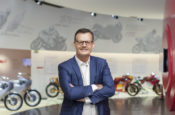Year Two
We catch up with AFT CEO Michael Lock and chat with him about the progress of the American Flat Track Championship.
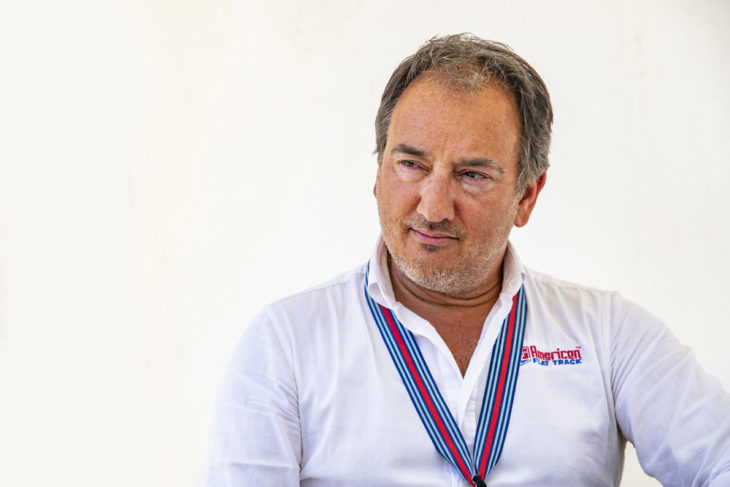
If 2017 was the year that America’s oldest form of motorcycle racing made its big comeback, with the rebranded 18-race AFT/American Flat Track Championship hosting a resumption of the historic struggle for dirt oval dominance between Indian and Harley-Davidson that was decisively won by the Wigwam tribe, 2018 has been a year of consolidation. Both spectator attendance and media audiences continue to ramp upwards, with tracks forced to close their gates early and disappoint latecomers thanks to yet another sell-out, while the sport is being brought to a far wider audience than had ever followed it before, via a series of hour-long weekly primetime telecasts streamed on NBCSN, which together with AFT’s own livestreaming of every round, are bringing the non-stop thrills and spectaculars spills of this uniquely American race series to a whole new global audience.
The man responsible for transforming what was previously the best kept secret of American motor sport into an accessible, slickly staged and artfully presented spectacle is Michael Lock, a 53-year old Brit who two years ago was hired by NASCAR boss Jim France, to revitalize a sport that he himself had a soft spot for. That’s because Jim’s the only member of the NASCAR hierarchy to have actually raced a motorcycle himself, and the 250cc Bultaco flat-tracker with which he did so now adorns Michael Lock’s office in Daytona Speedway, from where he’s plotted the comeback of America’s oldest two-wheeled sport.
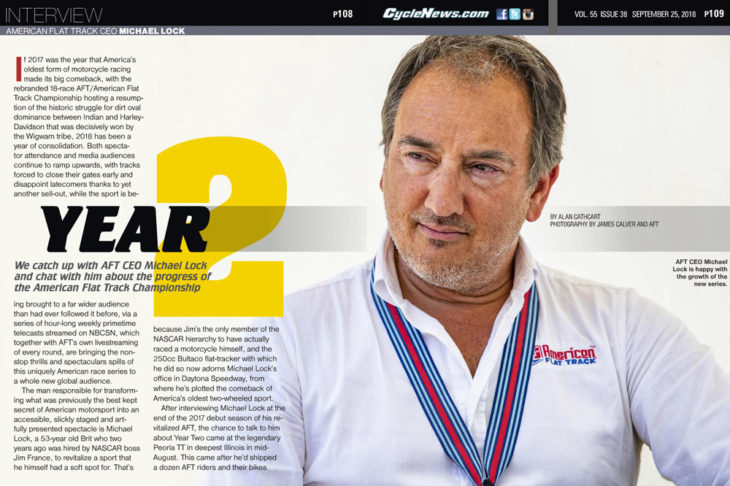
PHOTOGRAPHY BY JAMES CALVER AND AFT
Click here to read this in the Cycle News Digital Edition Magazine.
After interviewing Michael Lock at the end of the 2017 debut season of his revitalized AFT, the chance to talk to him about Year Two came at the legendary Peoria TT in deepest Illinois in mid-August. This came after he’d shipped a dozen AFT riders and their bikes to the UK the previous month, headed by number-one plate holder Jared Mees and fast lady Shayna Texter, to spread the word among the 240,000 fans from all over Europe attending the Duke of Richmond’s four-day motoring garden party, aka the Goodwood Festival of Speed. There, besides unleashing their knobbly-tired flat-trackers loose on the Goodwood hillclimb’s manicured grass verges, Mees, Texter & Co. each signed thousands of autographs and posed for hundreds of selfies as the large number of clued-up British fans for AFT pounced on their racing heroes who, till now, they’d only seen on screens. Speaking to Lock at Peoria the following month provided a chance to put that in perspective, as well as to evaluate the ongoing spectacle that is AFT, The Story So Far…
Michael, how has the AFT series evolved since you and NASCAR reinvented it last year?
In 2017 we implemented a lot of changes to the series, so it was all very new and very fresh. This year has been about how do we refine that, how do we keep everybody at the table? I’ve learnt that running a race series makes you into a politician—and hopefully a good one, because it seems they’re in short supply! We went to what I’d call a tournament-style evening, where you start with all the competitors in heat races, and you eliminate the slowest ones, and you get down to the semi-finals, and you eliminate the slowest ones, and then you get down to a final of 18 riders.
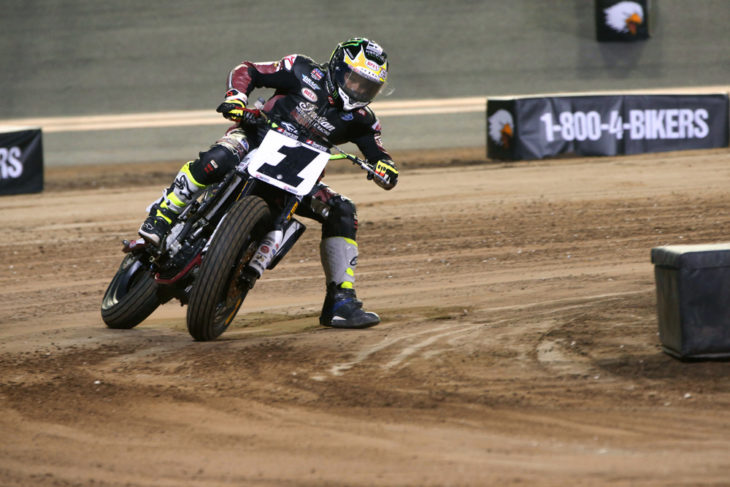
Last year was the debut season for the new AFT format with separate series for Singles and Twins. How has Year Two gone with that?
Remarkably well, and the two classes have developed very distinct characters. The best thing I can liken the Singles class to is, Moto 3 on dirt—and anyone who watches Moto 3 will know exactly what I mean. You often don’t know who’s going to win until the finish line, sometimes not even until you’ve seen the photo finish, and it could be one of 15 guys—or a girl! Obviously, our Singles are very closely matched, because they’re based on production 450 motocross bikes, which are incredibly similar, whatever the OEMs will tell you. And the tuning allowed in AFT Singles is fairly straightforward, so nobody has a power advantage, and nobody has a chassis advantage. So it’s about which kid has got the right setup, or the right degree of bravery that weekend to win. And we now have fans with incredible name recognition for the top five or six in Singles, who follow them loyally. I mean, Shayna Texter now has her own line of merchandise, which we market for her at events, and it’s one of our best-selling lines.
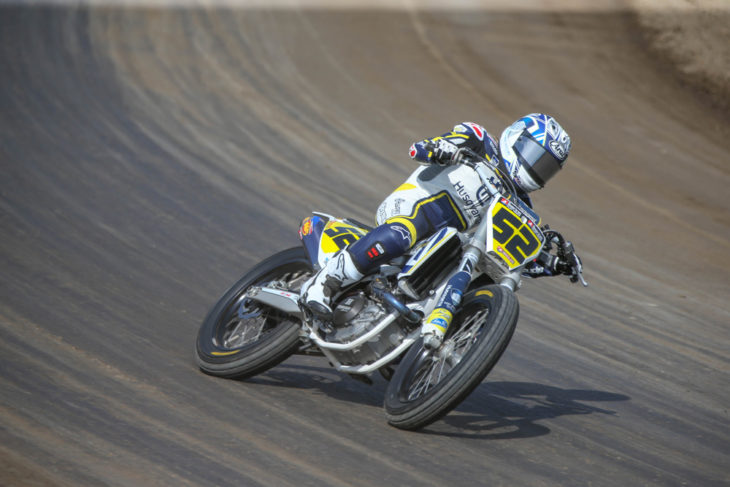
Has her success persuaded other women to come and race?
In the last year or so, as her visibility has raised, it’s certainly encouraged a lot more females to come to the races. We have a midprogram break, so we run qualifying and heat races, and then we take an hour’s break in the middle of our program, and we open the paddock to the public so that everybody can come in and mix with the racers, and get close up to them and the bikes, and chat to them. This usually coincides with sunset, when you don’t want the sun in the eyes of the racers, so we kill two birds with one stone. What I’ve noticed this year that the crowds are bigger, and they’re more engaged, and they also know who the stars are. But there are half a dozen racers for whom there’s always a line of people waiting to chat with them, and get autographs signed. Shayna is number one, and a high proportion of the people wanting a selfie with Shayna Texter are girls between the age of eight and 18, brought by their mums and very proud dads! Shayna certainly has a story that resonates—it’s still very much a rarity to have a female who’s actually successful in a male-dominated sport, not merely there to make up the numbers.
Our TV partner NBC understands that, and they’re obviously very keen on Shayna, to the point that they tap her on the shoulder every now and then to do something on other NBC products. So she’s been interviewed in studio on the NASCAR America Show, talking about how flat track and NASCAR have similarities or differences, and what the fans should look out for. She’s becoming a bit of a celebrity, and she seems to have a natural gift for being articulate in public, in spite of being so unassuming. And she’s a nice person, as well as a winning racer, which always helps!

Some might say that’s possibly her problem, because you mustn’t be a nice person in TT racing, and being only five foot tall, she can’t throw her weight around!
I think you’re right, because what separated Shayna from actually winning the Singles championship last year, were the three TTs in which she didn’t make the main event and scored zero points—just like here at Peoria, where she came off the bike in practice, and didn’t make the main. TT racing is very physically intimidating—you have to push people out of the way in a turn, whereas her skill and her advantage is in drafting on straights at high speed, where her lack of weight gives her an edge, and her lack of height makes her more aerodynamic. But she weighs just 98 pounds and that hurts her on the starts, where you need that rear-wheel traction.
But you have a lot more miles now, where small stature becomes advantageous.
Half the series are miles, for a couple of reasons. One is the sheer drama of the miles, just listening to the grandstand as the bikes come out of turn two along the back straight and are getting up to top speed. The second reason is the venues, which are increasingly horse tracks. They’re all over America, and they’re generally in cities, not two hours’ travel away from one, and they have modern amenities, with air conditioning and restrooms your wife won’t beat you over the head for making her use.
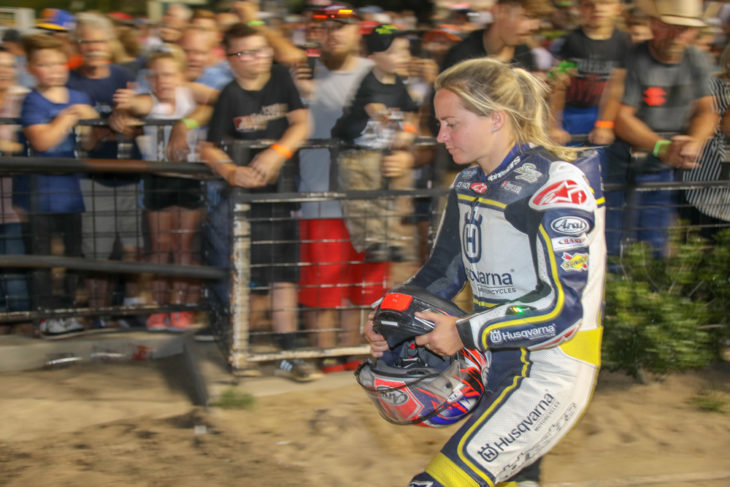
Has it been problematic that Indian has been so dominant after you succeeded in persuading them to return to racing?
Since coming back in they’ve been wildly successful, and now it’s almost impossible to win a race unless you’re on an Indian. If that situation remains for five years I’ve got a problem—but it won’t. Quite apart from Harley-Davidson, which isn’t going to put up with getting its face wiped by Indian race on race, year on year, we have an Austrian manufacturer coming in next year, which doesn’t go racing except to win. KTM has absolutely no intention of just making up the numbers here. Their approach is, “We like the sport, we like the direction, we like the demographic of your audience, we like what it could say about our brand, so we’re going to come in and beat everybody. And by the way, here we have a perfect platform in the form of our middleweight 790 Duke street bike that’s built to race.” It has a very nice compact parallel-twin engine, and I think that within 12 months, when that bike comes out of the R&D loop, it will shock the AFT world in a very positive way.
When is KTM actually joining in?
Next year. KTM will have Stage 1 of their factory team competing in the 450 Singles class, and they’ll be on the grid at Daytona next March. That’s Stage 1. They’re already developing their Twins racer based on the 790 Duke, with the plan of being on track 12 months later for the 2020 season, or maybe earlier—they may possibly run in the last round or two of next year’s schedule,.
Fans expected Kawasaki to be more competitive than they have been, if only because they won the title two years ago with a rider who then transferred to Indian. But where has Kawasaki gone since?
Well, the successful Kawasaki racing effort was a double act, with Ricky Howerton being the team owner and crew chief as well as the tuner; and Bryan Smith the rider. Over several years, Ricky had built a green and black bike based on a 650 engine that was really his creation, so when he went to Indian with Bryan, that technology went, too. And the remaining Kawasakis in the paddock, competent as they are, have struggled to keep up with the power and sophistication of the Indian—well, all except for Henry Wiles’ TT bike! [Wiles went on to register Kawasaki’s first win of the 2018 season later that weekend at Peoria.] I think sophistication is really the key word with the FTR750. If you look at the raw data—so, power output, torque output, weight, technology—there’s nothing actually that remarkable about the Indian. It’s just that the entire package across all four formats of our series has been so beautifully put together. And that’s been demonstrated by the fact that now that they’ve started selling privateer bikes, their customers have been riding up front, too. Jeffrey Carver’s one of them. He beat Jared Mees at the Springfield Mile, the most famous race in our series, and it wasn’t that Jared was sitting back enjoying the view, or anything!
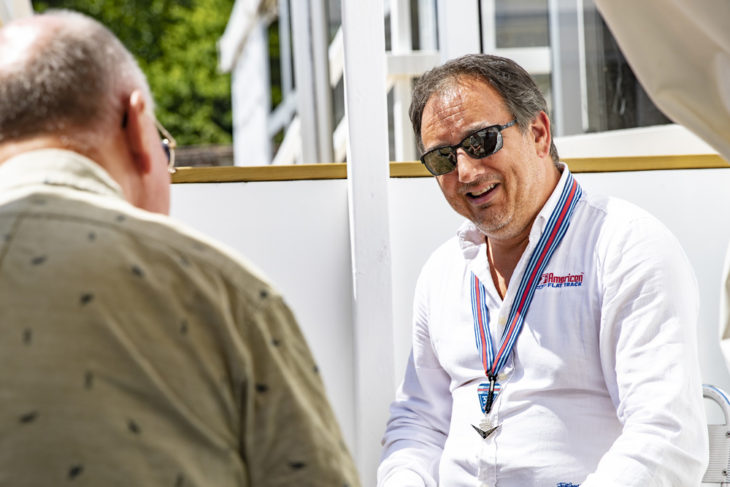
Yamaha came in this year, but in a slightly half-hearted way. Will that change?
Look, there’s no secret that the street motorcycle market in the U.S. is challenged. It’s challenged worldwide, but the U.S. is a peculiar market in that it’s dominated by big bikes, no one buys anything under 500cc in the U.S. So what that means for all the manufacturers is that their volume has shrunk, and when the volume shrinks, budget shrinks, when budgets shrink, no one goes racing so much. Road racing in the U.S. has a glorious history, but it’s in a difficult place at the moment. I know from speaking to [Yamaha] that they’d love to be involved in flat track, but there’s only so many ways the dollar can be cut. So they’ve said, if we can find a way, if we can get an external sponsor to partner with us, we’ll be there in a heartbeat. So I would say, look out for Yamaha in the 2019 AFT series.
How about Triumph, a company with which you have historic personal connections?!
I have an active dialog with Triumph, and I was in their Hinckley factory after Goodwood. They like flat track racing, they get it, and it’s perfect for their brand in America, plus they do some Hooligan racing in the U.K. They’ve looked at our Twins Championship, and said, “yes, we do have a 900 that would conform to it, but it’s not a competitive package—the motor’s big and relatively heavy, plus it doesn’t rev that high. What I know about Triumph after working for them for so long is that they wouldn’t want to come in to make up the numbers. I get that. So under our current format, I don’t think they’re ready to push the button, but if anything changes, either in platforms they have, or in our racing format, I think they’d be there in a heartbeat.
But a company whose race boss is a big fan of AFT, is Ducati. When is Ducati coming to Flat Track? They’re already there, but only with a privateer team.
The guys at Ducati from top to bottom are pure racers. And they want to win every race in everything they ever do. I was in Bologna last month to see them. What they’ve done with their Scrambler and all the spin offs from that, has opened up a wide new world for Ducati—a lifestyle oriented, urban biker world, in which I know they see the synergy with flat track racing. They’ve had a toe in the AFT water with the Lloyd Brothers Team, who this year switched from a two-valve air-cooled motor in their flat track bike, to a liquid-cooled eight-valve 821. The bike’s nice, and the motor is a core product for Ducati. Every time I see [Ducati race boss] Paolo Ciabatti, he says, “Michael, we love AFT, but this is pretty scary racing—we don’t yet know enough about it!” So I know they’re in a learning process about what flat track is, who the audience is, how you win. So my goal is to get them to step up and really contribute to the series, and the biggest argument I’ve got in favor of their doing that is called KTM, which is ever increasingly a key rival for Ducati.
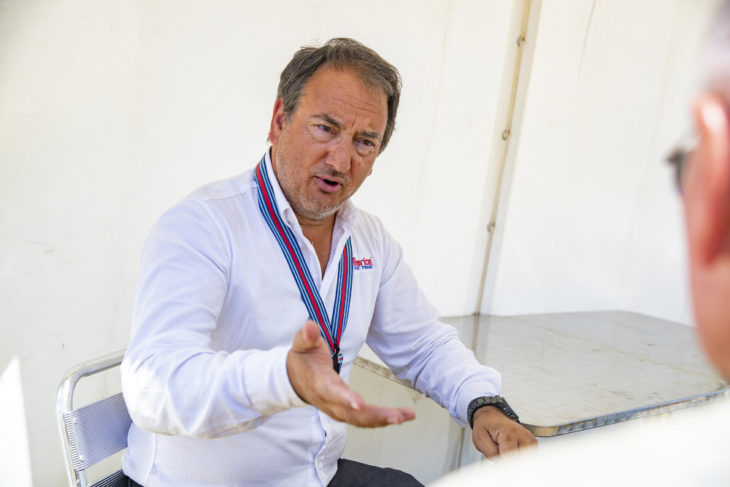
So that brings us to Harley-Davidson. It seemed that in Year One, Indian’s dominance possibly caught Harley on the back foot, because they weren’t prepared for them to be so successful, so fast. But in Year Two, it’s evident that Harley still can’t claw back any of the gap in competitively that they had between their XG750R and the Indian FTR750.
Harley-Davidson made the XR750 that was introduced in 1970 and has won 681 flat-track nationals so far, and is still quite competitive today. To replace that, they’ve created the XG750R and are working together with Vance & Hines, which is not exactly an incompetent performance company! Terry Vance, the co-founder of the company, is crew chief and team manager, and comes to every single race. He and his V&H guys in Indianapolis are burning the midnight oil to redress the balance. So it’s not a lack of effort that’s responsible for Harley not being competitive, and it’s certainly not a lack of competence, because Terry and his team are really the best in the business. I think you have to go back to the planning stage a couple of years ago to see what their challenge is. At that time, Indian up in Minneapolis was sitting in a darkened room, saying, “The way to win in flat track is to build a race bike from a clean sheet of paper.” There was another group of people in Milwaukee just down the road, sitting in a different darkened room saying, “What a great idea it’d be to promote our new street line of 500s and 750s designed for a whole new audience for Harley, and use that as the basis for an expert flat track bike.” You can’t argue with either decision, it’s just that one of them so far has been immediately successful, and the other is much more of a slow burner.
So I don’t know what the future holds for the Harley project, because they can go one of two ways, can’t they? They can either say, “Let’s identify what the barriers to success are with this current platform, and let’s re-engineer those and R&D our way out of it.” Or, they can put the existing bike up on a shelf in their Museum with a plaque underneath it, and come out with a brand new purpose-built racer. That’s up to them, but I do know that they’re fully committed to flat track, both now and in the future.
You brought AFT to the Goodwood Festival of Speed in July. Were you surprised at how much people in Britain already knew about the AFT series?
It was just amazing—overwhelming, actually. I guess today the world’s a small place, and information is available readily and instantly. But because we livestream all our racing on fanschoice.tv with the same footage that we’re shooting for our NBC show—it’s not edited, obviously, because it’s live—and that’s free to air, anyone in the world can watch it on their cell phone if they want. We’re finding that people in many countries outside the USA are doing that now, so there’s a familiarity with our stars, and our bikes.
Can you identify which countries?
Certainly, but be ready to be as surprised as we were. The number-one market for our livestreaming is naturally the USA, but India, Thailand, and Brazil make up the next three, and not so far behind! Of the European countries, the U.K. and Spain are way ahead of everywhere else. Partly that’s because we have a British rider in our series this year who’s doing quite well, a young lad from Yorkshire named Oliver Brindley who’s racing in the Singles Championship, got a podium at Springfield, and is a hot prospect for the future. So that’s peaked interest in the U.K. Spain has its own flat track league, and is obviously a motorcycle mad country. We’ve had a couple of Spanish riders come and do selected races, so we’re getting some interest there. But the countries that really consume AFT are bike-mad countries where their youth use motorcycles as a primary form of transport, as well as being emerging economies with a good wireless infrastructure.
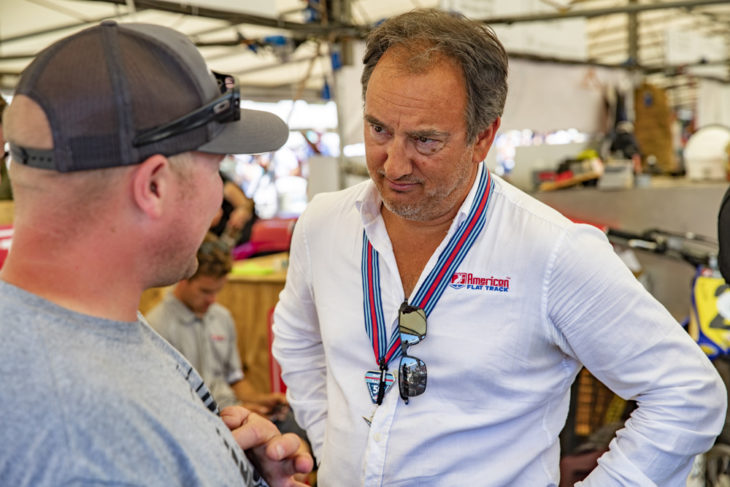
So do you envisage running an AFT round in a foreign country, outside the USA?
I’d love to do that, and I’m actively working on it.
In the same way that right now 75% of the world’s manufacturers have got some kind of street scrambler in their line-up, three years from now their likely must-have will be a street tracker, especially after the impending debut of the Indian FTR 1200. How does AFT respond to that?
I think you’re right and, look, there’s no doubt that’ll help us, and if in turn we can help the marketplace, then we’ve got something more than a fad. Because I’ve looked at the café racer thing, and of course the scrambler thing, and they’re pretty much fun bikes, and in a motorcycle world that’s maybe become a little stale, it’s nice to have a new design aesthetic, a new riding experience that’s cool and different.CN
Click here to read this in the Cycle News Digital Edition Magazine.
Click here for all the latest motorcycle Industry News on Cycle News.
Click here for all the latest Flat Track racing news.
